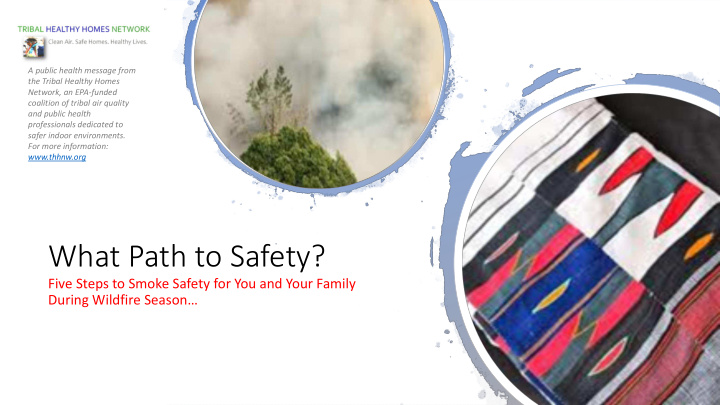



A public health message from the Tribal Healthy Homes Network, an EPA-funded coalition of tribal air quality and public health professionals dedicated to safer indoor environments. For more information: www.thhnw.org What Path to Safety? Five Steps to Smoke Safety for You and Your Family During Wildfire Season…
Wildfire smoke is toxic 1 …and sometimes troublesome. It finds its way inside our homes, our heart and lungs, bloodstream, even our brains. At high levels, it can even put us in the hospital. But it doesn’t have to… Take a few minutes to empower and protect yourself through these five, scientifically based steps.
1. Get out of the smoke. Spend as much time as possible in a filtered indoor environment.
1. Get out of the smoke. ✓ When wildfire smoke is in your area, spend as much time as possible in a filtered indoor environment. ✓ What is “filtered”? A room, building or space where smoke is filtered out through a portable air filter (or “air cleaner”), through an HVAC system, or even through a low-cost but effective box fan. ✓ If the Air Quality Index (AQI) in your area is in the “Unhealthy for Sensitive Groups” range, take heed and stay inside. ✓ Who is sensitive? Children, pregnant women, elders, those with lung disease, heart disease, diabetes or a compromised immune system. To get started, look at EPA’s general guidance on reducing your smoke exposure.
2. Slow down. Reduce your exposure by reducing your overall activity.
2. Slow down. ✓ The more active you are, the higher your respiration rate. In turn, the more you breathe, the more smoke you inhale. ✓ Errands, heavy labor, strenuous exercise…even light housework… consider doing less until the air quality improves. ✓ If you, your family or your children need to be active (as we all do at times), look for alternatives, like YMCAs, gyms, or community centers that have an air filtration system. ✓ If you have COPD, keep it low key until the air quality improves…avoid heavy labor, avoid frying foods, ask friends for help with errands. To learn more about the health impacts on children, see the EPA and American Academy of Pediatrics guidance on protecting children from wildfire smoke and ash.
3. Know Your Numbers. Use a website, app or the news to track air quality levels.
3. Know Your Numbers (and your colors) . ✓ The Air Quality Index (AQI) is a scale between 0 and 500 and represents current air quality conditions. ✓ Tribal, state and federal air quality agencies use the AQI to communicate with us about air quality and its relative safety – or risk. ✓ The higher the number, the more important it is to modify your day…to reconsider what you do, where you go, where you stay. ✓ To know the numbers (and colors) in your area, make a daily habit of checking your preferred websites, apps or local news. ✓ Sign up for a program that emails you daily, local, real-time air quality info, such as AirVisual To get started, check out EPA’s AirNow website
4. Use a Mask. Protect yourself, when outside, with a mask.
4. Use a Mask. ✓ If you must go outside (or if you work outside) when air quality is poor, a mask can reduce your exposure. ✓ The key to protection is wearing the right mask (an N-95 or N-100), the right way. Proper fit is essential. ✓ Have heart or lung disease? Talk to your doctor before wearing a mask. ✓ Know that masks are not designed to fit young children or adults with facial hair, which may prevent a proper fit. To get started on learning about proper mask type and fit, check out EPA’s respirator guidance .
5. Filter Your Air. Create your own “clean room” with filters and fans.
5. Filter Your Air. ✓ During wildfires, very small particles and odorless gases from the smoke, such as Carbon Monoxide, can enter our homes. (Every home and apartment is different, but up to 70% of pollutants in the outdoor air are also found inside our homes.) ✓ In addition to keeping windows and doors closed, filtration of the air in your home will keep you safer and more comfortable on smoky days. ✓ High heat is also a risk factor, so creating your “clean room” may also involve an air conditioner or swamp cooler. To get started, look at EPA’s guidance on filtration options for your home, or this guidance on building your own (very effective) air cleaner, using just a box fan and a furnace filter, for around $40.
Recommend
More recommend